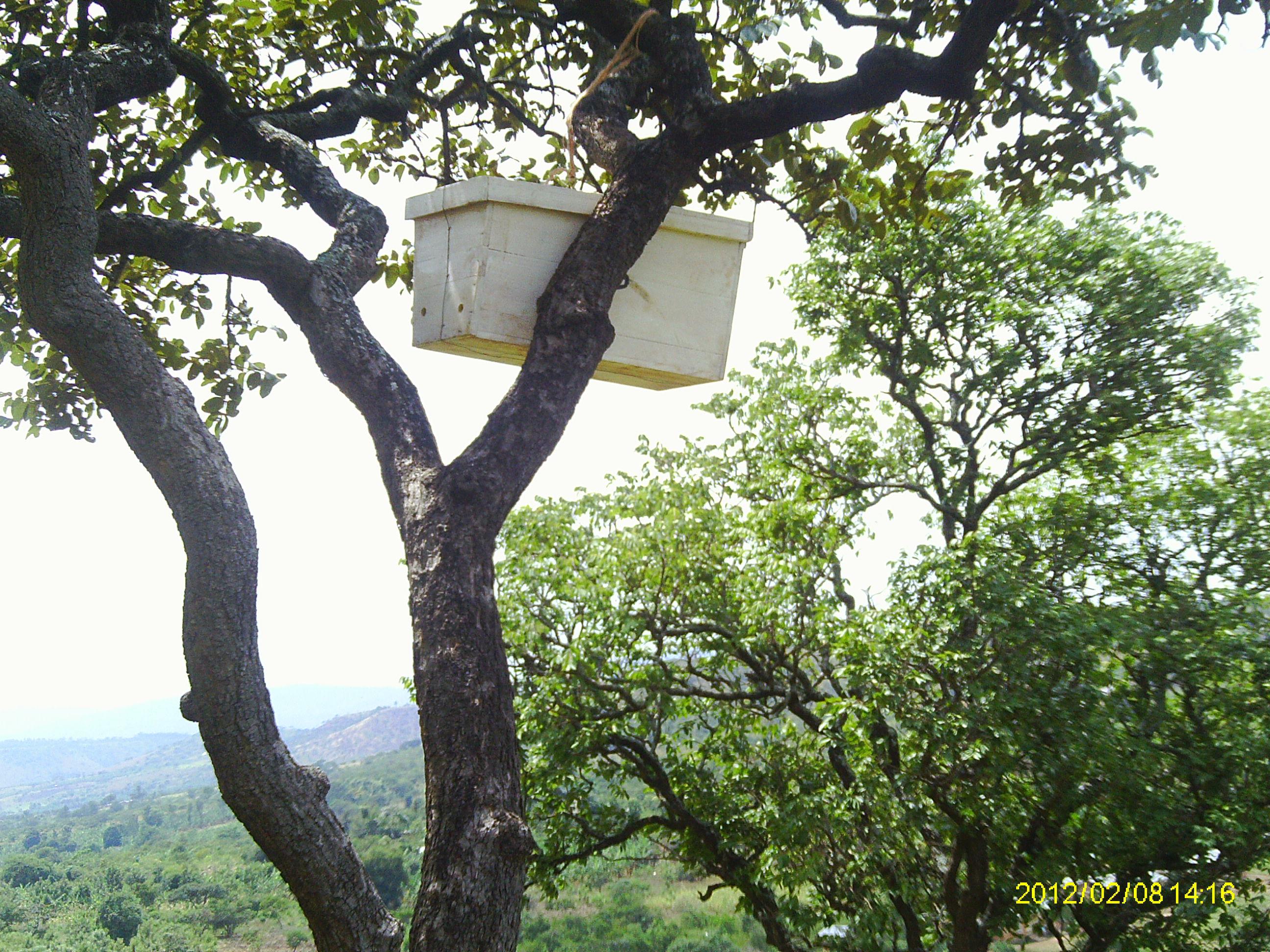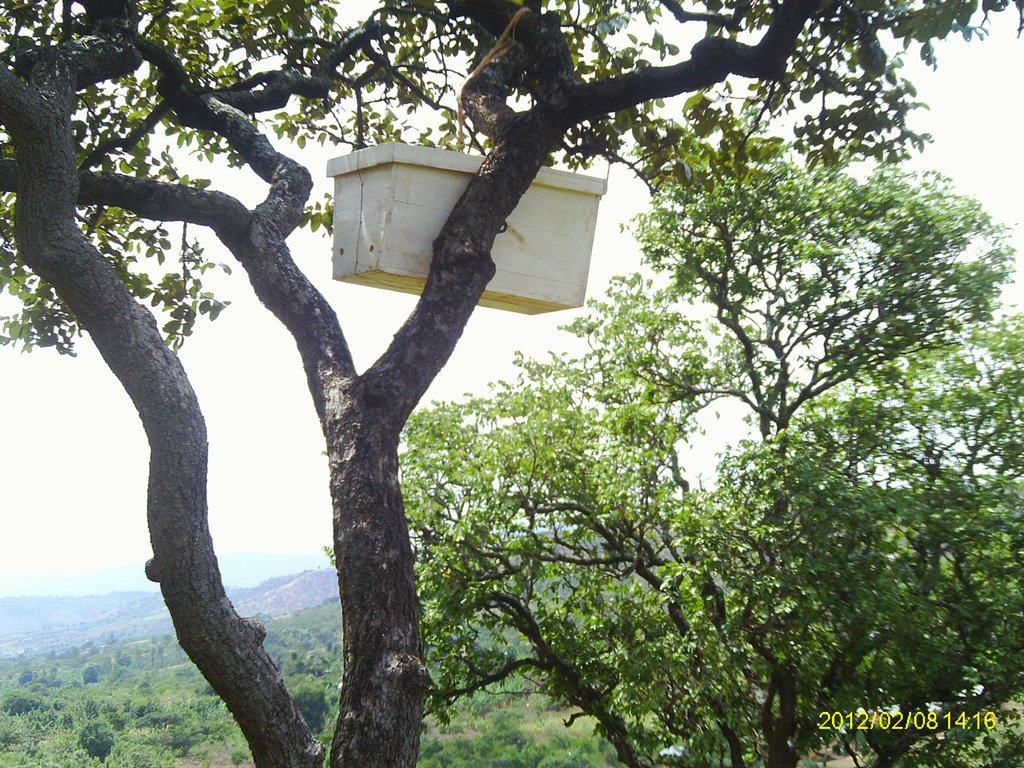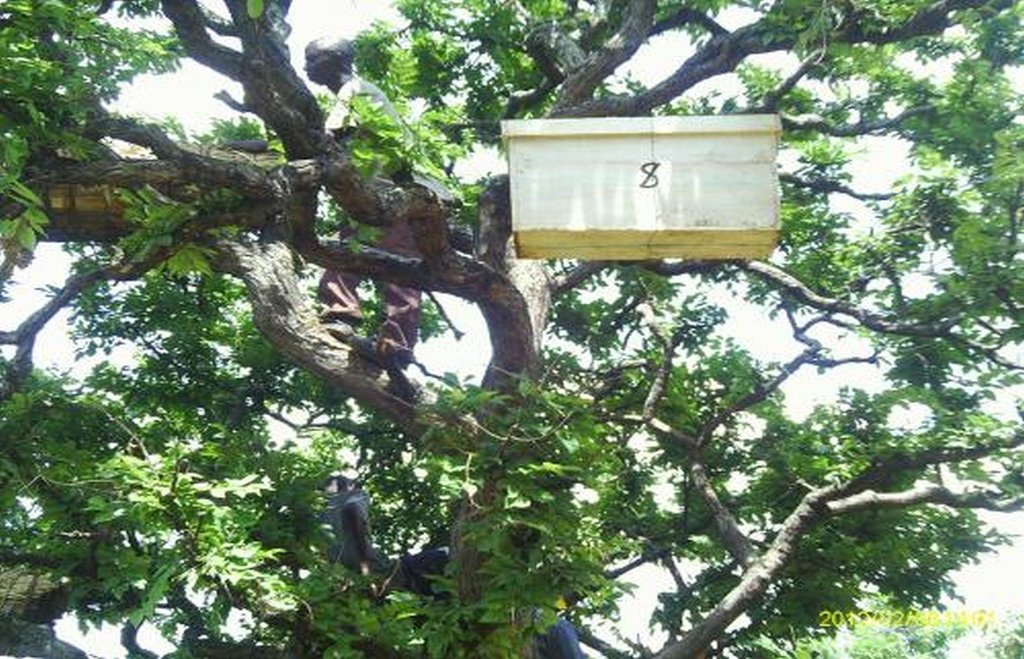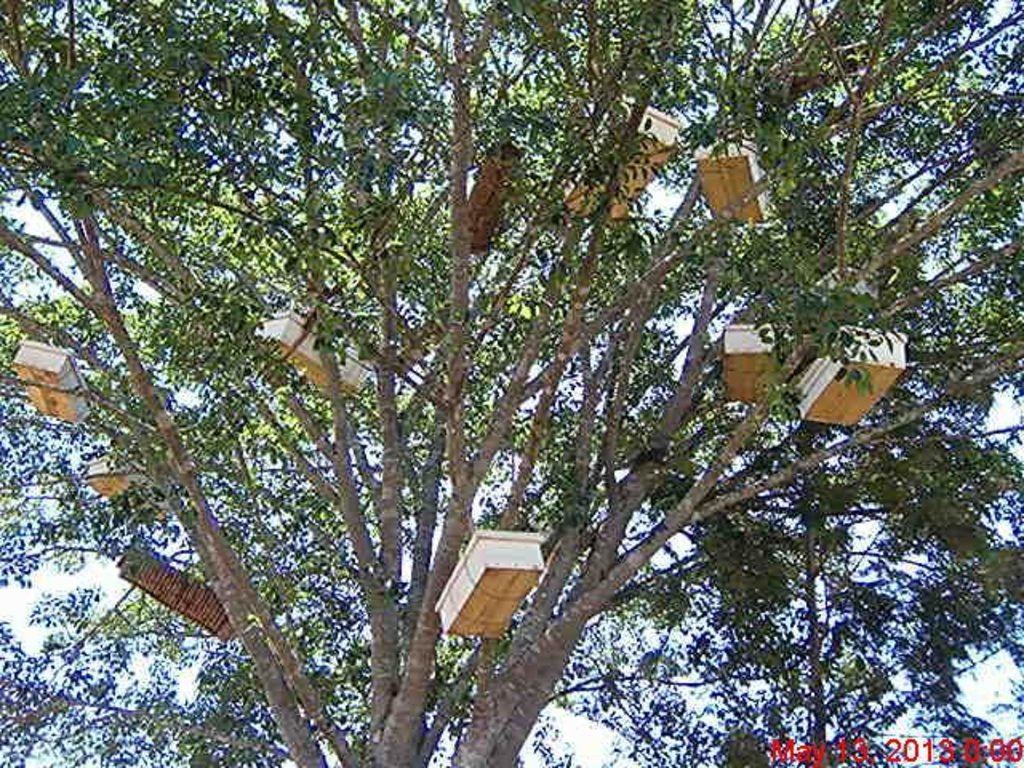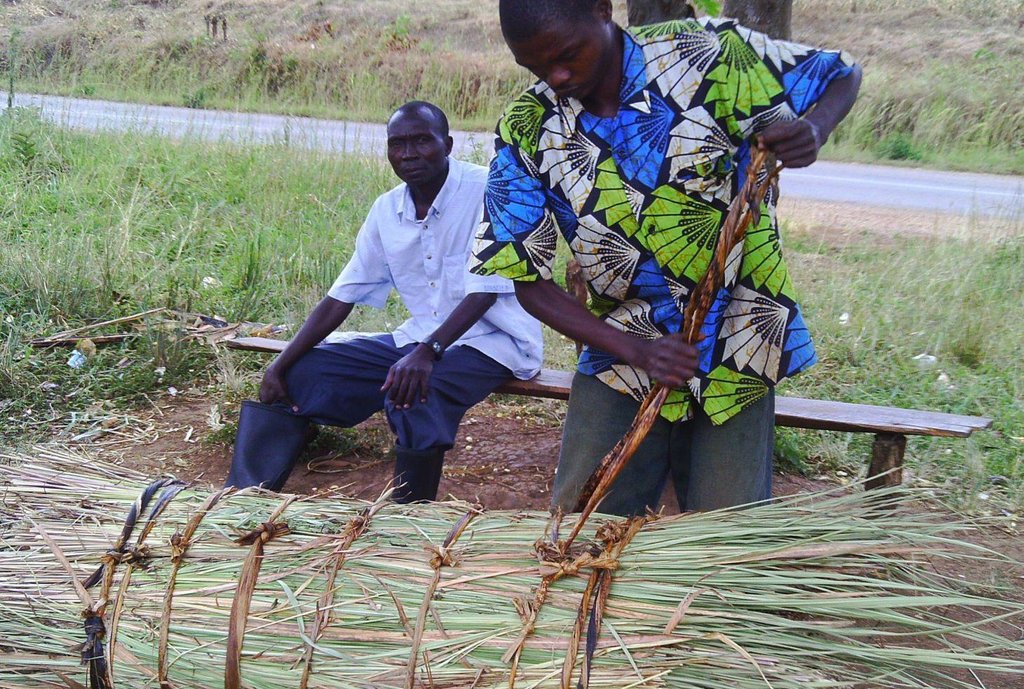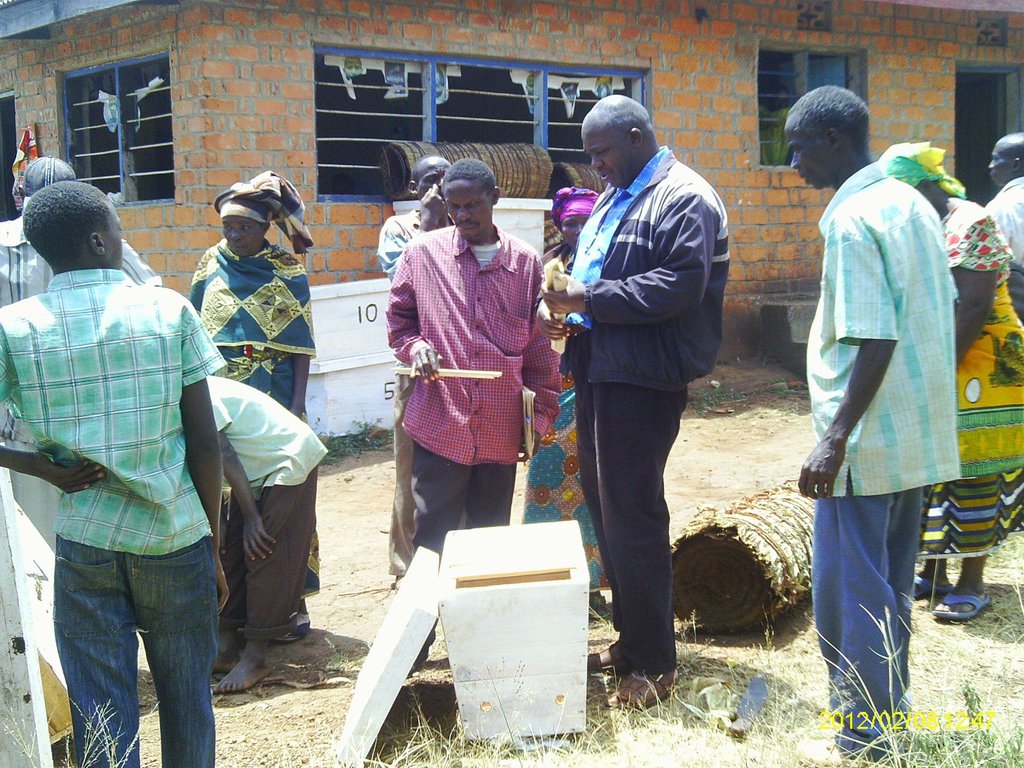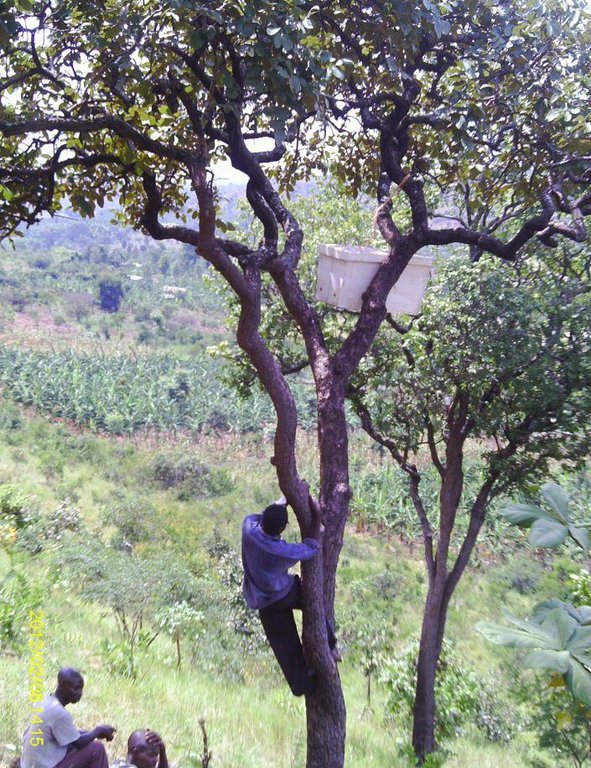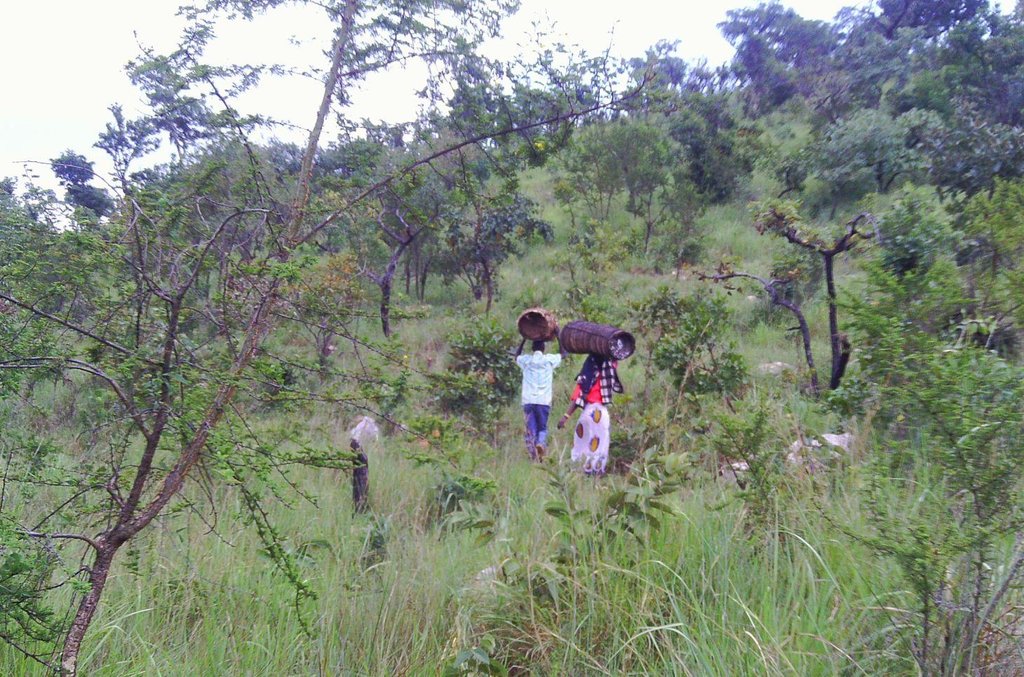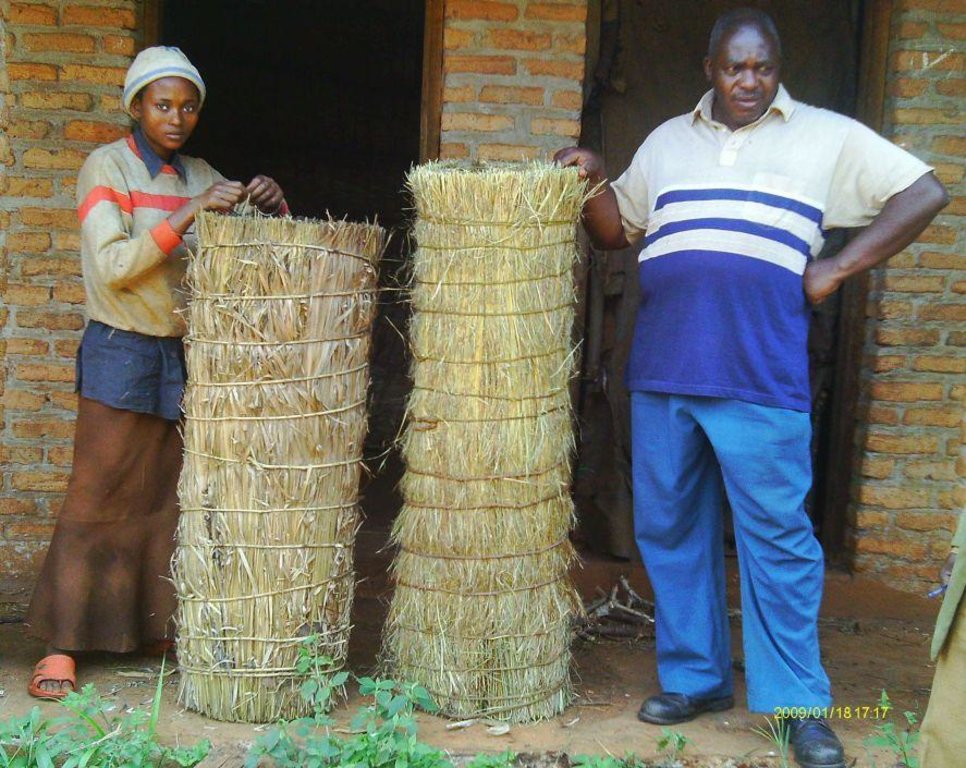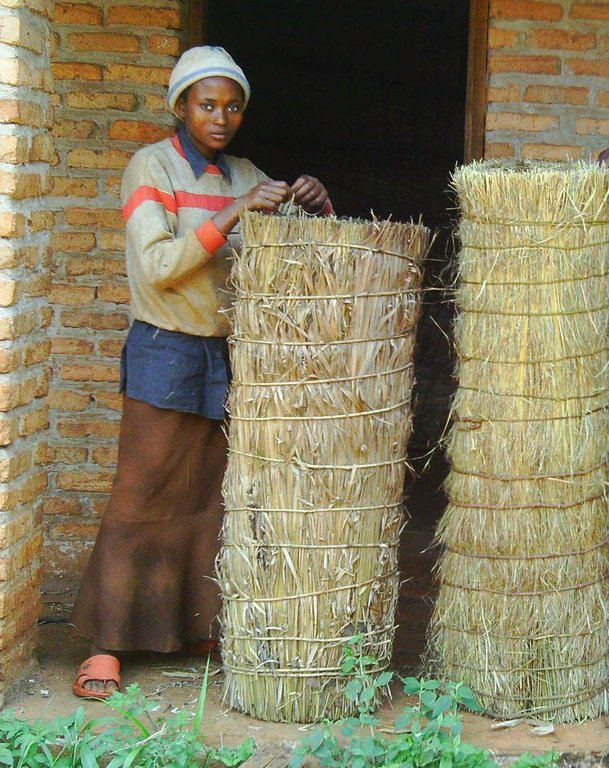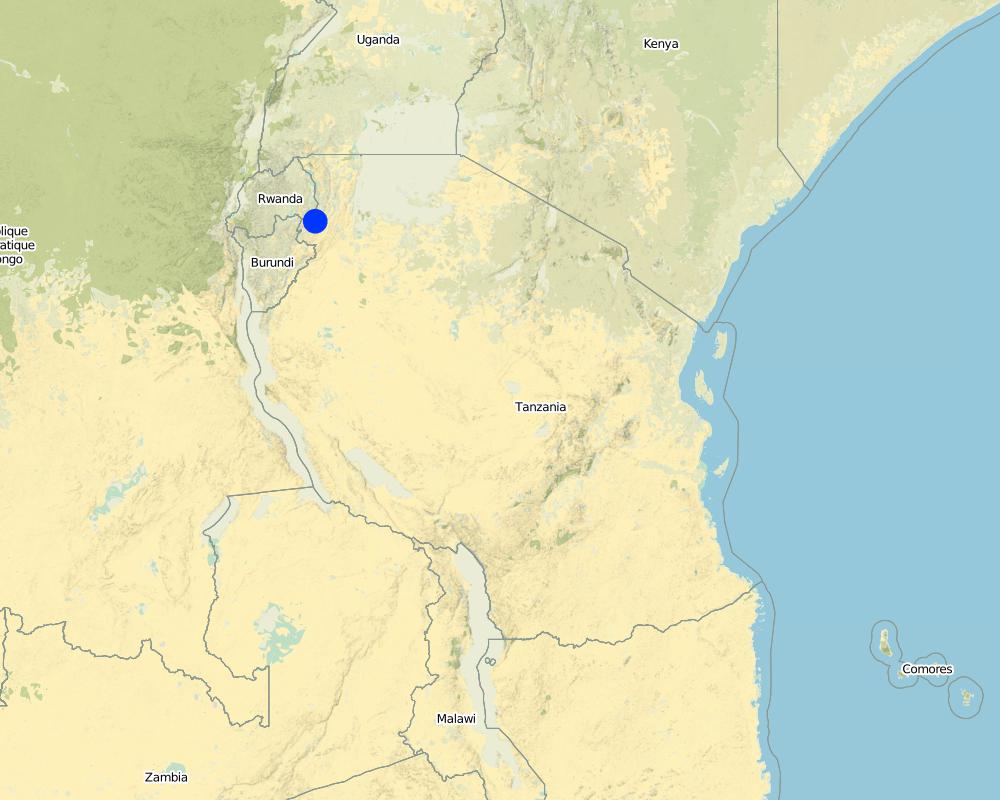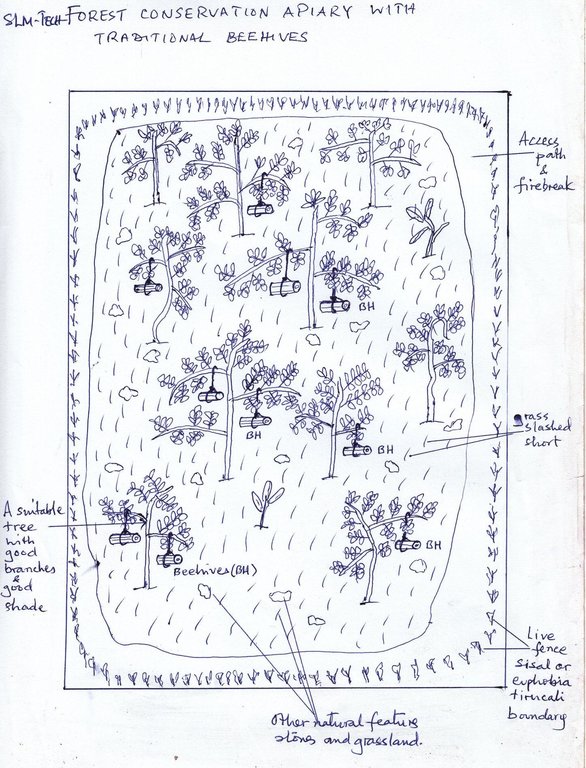Natural forest conservation using apiaries [แทนซาเนีย]
- ผู้สร้างสรรค์:
- การอัพเดท:
- ผู้รวบรวม: Philip Ileta
- ผู้เรียบเรียง: –
- ผู้ตรวจสอบ: David Streiff, Alexandra Gavilano
Utunzaji misitu kwa kufuga nyuki (swahili),
technologies_1152 - แทนซาเนีย
ดูส่วนย่อย
ขยายทั้งหมด ย่อทั้งหมด1. ข้อมูลทั่วไป
1.2 รายละเอียดที่ติดต่อได้ของผู้รวบรวมและองค์กรที่เกี่ยวข้องในการประเมินและการจัดเตรียมทำเอกสารของเทคโนโลยี
ผู้เชี่ยวชาญ SLM:
Government:
Waluce Michael
Ngara District Council
แทนซาเนีย
Government:
Mugishagwe Wilson
Ngara District Council
แทนซาเนีย
Government:
Sangatati Josephat
Ngara District Council
แทนซาเนีย
ผู้เชี่ยวชาญ SLM:
Kaihura Fidelis
K-TAMP
แทนซาเนีย
ชื่อของโครงการซึ่งอำนวยความสะดวกในการทำเอกสารหรือการประเมินเทคโนโลยี (ถ้าเกี่ยวข้อง)
The Transboundary Agro-ecosystem Management Project for the Kagera River Basin (GEF-FAO / Kagera TAMP )ชื่อขององค์กรซึ่งอำนวยความสะดวกในการทำเอกสารหรือการประเมินเทคโนโลยี (ถ้าเกี่ยวข้อง)
FAO Food and Agriculture Organization (FAO Food and Agriculture Organization) - อิตาลีชื่อขององค์กรซึ่งอำนวยความสะดวกในการทำเอกสารหรือการประเมินเทคโนโลยี (ถ้าเกี่ยวข้อง)
Ngara District Council (Ngara District Council) - แทนซาเนีย1.3 เงื่อนไขการใช้ข้อมูลที่ได้บันทึกผ่านทาง WOCAT
ผู้รวบรวมและวิทยากรหลักยอมรับเงื่อนไขเกี่ยวกับการใช้ข้อมูลที่ถูกบันทึกผ่านทาง WOCAT:
ใช่
1.5 Reference to Questionnaire(s) on SLM Approaches (documented using WOCAT)
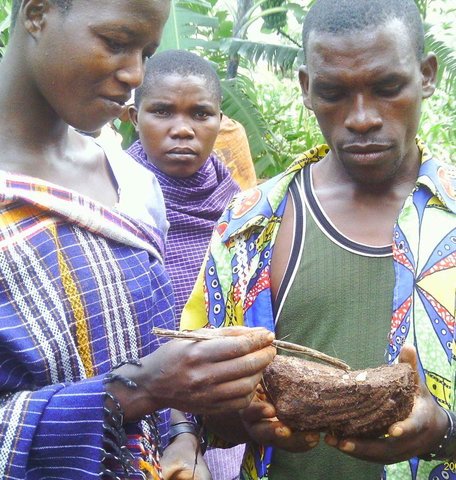
Community intergrated catchment ecosystem management [แทนซาเนีย]
Adaptive Agro-ecosystem Micro-catchment Approach.
- ผู้รวบรวม: ALLAN BUBELWA
2. การอธิบายลักษณะของเทคโนโลยี SLM
2.1 การอธิบายแบบสั้น ๆ ของเทคโนโลยี
คำจำกัดความของเทคโนโลยี:
Establishment of apiaries in natural forests to retard forest mismanagement and improve honey production
2.2 การอธิบายแบบละเอียดของเทคโนโลยี
คำอธิบาย:
This technology has been practiced in Ngara region for the last 50 year and involves construction and upkeep of apiaries for honey and related goods production. The apiaries are constructed by farmers (traditional) or purchased (modern box hieves) and then positioned in a designated forest area that is away from settlements and public places. The apiaries should be hanged on a strong branches of trees with good shade and the honey production process takes from 9 to 12 months.
Purpose of the Technology: It is recommended to apply this technology in the forest that is exposed to deforestation as apiaries help to enhance forest protection. The establishment of apiaries help to improve management of the natural forest while increasing production of honey. This will contribute to the better livelihood of the community and environmental wellbeing.
Establishment / maintenance activities and inputs: The described technology covers area of enclosed 4 hectares of natural forest and establishment of 365 apiaries (338 traditional, 27 box hives); the group of practitioners consist of 10 members (7 male and 3 female). The establishment procedures require: a) identification of forest at risk of degradation, b) ermarcation of the apiary forest, c) creefing of fire breaks d) reparations for and hanging the beehives (traditional and box hives). Maintanance acivities include a) regular slashing of grasses and bushes around the trees with hives b)grading with hand hoes the fire breaks/ roads around the entire forest for fire protection before each dry season c) cleaning of hives,repairs and harvest honey with bee protectives (bee smoker,bee veils,gloves) to eliminate the risks of fire in the forest.Patrol and guard tresspassers d) monitoring pests and diseases
Natural / human environment: Natural occuring tree species include: Combretus spp., Albizia spp., Parinari spp., Pericopsis spp. and Eucalyptus woodlots. Grazing areas are nearby but restricted by village by laws to tress pass in the forest apiary
The aipiaries should be located near permanent water sources because bees use water for honey production and cooling in the hives. Farmers with bee hives become more committed to protect their forest when they hang beehives in the area. Honey is harvested for consumption, trade and medicinal mixtures
The land users are small scale subsistance farmers with poor to average income/wealth,organised as a group of 10 farmers. the population density is between 200-500 people per square km and anual population growth at 2-3% Land ownership is both individual and communal but there are natural forestl areas owned communally through village governments where groups may access temporarily by request to establish environmental friendly activities such as forest apiaries.
2.3 รูปภาพของเทคโนโลยี
2.5 ประเทศภูมิภาค หรือสถานที่ตั้งที่เทคโนโลยีได้นำไปใช้และได้รับการครอบคลุมโดยการประเมินนี้
ประเทศ:
แทนซาเนีย
ภูมิภาค/รัฐ/จังหวัด:
Tanzania
ข้อมูลจำเพาะเพิ่มเติมของสถานที่ตั้ง :
Ngara District
ระบุการกระจายตัวของเทคโนโลยี:
- กระจายไปอย่างสม่ำเสมอในพื้นที่
If precise area is not known, indicate approximate area covered:
- < 0.1 ตร.กม.(10 เฮกตาร์)
แสดงความคิดเห็น:
The described technology covers area of enclosed 4 hectares of natural forest. Applied 365 bee hives (338 traditional, 27 box hives); the practitioners group has 10 members (7male and 3 female)
Map
×2.6 วันที่การดำเนินการ
ถ้าไม่รู้ปีที่แน่นอน ให้ระบุวันที่โดยประมาณ:
- มากกว่า 50 ปี (แบบดั้งเดิม)
2.7 คำแนะนำของเทคโนโลยี
ให้ระบุว่าเทคโนโลยีถูกแนะนำเข้ามาอย่างไร:
- เป็นส่วนหนึ่งของระบบแบบดั้งเดิมที่ทำก้นอยู่ (> 50 ปี)
ความคิดเห็น (ประเภทของโครงการ เป็นต้น) :
Beekeeping using local hives is a tradtional practice among the the Hangaza and Shubi ethinic tribes of Ngara district
3. การจัดประเภทของเทคโนโลยี SLM
3.1 วัตถุประสงค์หลักของเทคโนโลยี
- ป้องกันพื้นที่ลุ่มน้ำ/บริเวณท้ายน้ำ โดยร่วมกับเทคโนโลยีอื่นๆ
- รักษาสภาพหรือปรับปรุงความหลากหลายทางชีวภาพ
3.2 ประเภทของการใช้ที่ดินในปัจจุบันที่ได้นำเทคโนโลยีไปใช้

ป่า/พื้นที่ทำไม้
- Combretus spp., Albizia spp., Parinari spp., Pericopsis spp. and Eucalyptus woodlots
ผลิตภัณฑ์และบริการ:
- ไม้ที่นำมาทำเป็นเชื้อเพลิง
- ผลิตภัณฑ์อื่น ๆ จากป่า
- การแทะเล็มหญ้า / การเก็บกินหญ้า
- การอนุรักษ์ / ป้องกันธรรมชาติ
แสดงความคิดเห็น:
Major land use problems (compiler’s opinion): Deforestation and fire burning during dry season
Reduction of biodiversity
Major land use problems (land users’ perception): Droughts and vegetation burning during dry seasons
Problems / comments regarding forest use: the natural forest has been set aside for establishing bee apiaries therefore only forest managenet operation are conducted(slashing of grass)
3.4 การใช้น้ำ
แสดงความคิดเห็น:
Number of growing seasons per year:
2
Specify:
Longest growing period in days: 120; Longest growing period from month to month: Sept-December; Second longest growing period in days: 90; Second longest growing period from month to month: March to May
3.5 กลุ่ม SLM ที่ตรงกับเทคโนโลยีนี้
- การปิดล้อมพื้นที่ (หยุดการใช้ประโยชน์ สนับสนุนการฟื้นฟู)
- การเลี้ยงผึ้ง การเพาะเลี้ยงสัตว์น้ำ สัตว์ปีก ฟาร์มกระต่าย ฟาร์มหนอนไหม
3.6 มาตรการ SLM ที่ประกอบกันเป็นเทคโนโลยี

มาตรการจัดการพืช
- A7: Others

มาตรการอนุรักษ์ด้วยการจัดการ
- M3: การวางผังตามสิ่งแวดล้อมทางธรรมชาติและสิ่งแวดล้อมของมนุษย์
3.7 รูปแบบหลักของการเสื่อมโทรมของที่ดินที่ได้รับการแก้ไขโดยเทคโนโลยี

การเสื่อมโทรมของดินทางด้านชีวภาพ
- Bc (Reduction of vegetation cover): การลดลงของจำนวนพืชที่ปกคลุมดิน
- Bh (Loss of habitat): การสูญเสียแหล่งที่อยู่
- Bq (Quantity/biomass decline): การลดลงของปริมาณหรือมวลชีวภาพ
- Bf (Detrimenta leffects of fires): ผลเสียหายจากไฟ
- Bs (Quality and species composition): องค์ประกอบหรือความหลากหลายทางคุณภาพและชนิดพันธุ์ลดลง
แสดงความคิดเห็น:
Main type of degradation addressed: Bc: reduction of vegetation cover, Bh: loss of habitats, Bq: quantity / biomass decline, Bf: detrimental effects of fires, Bs: quality and species composition /diversity decline
Main causes of degradation: deforestation / removal of natural vegetation (incl. forest fires) (Deforestation through cutting of trees), over-exploitation of vegetation for domestic use (Mainly for firewood), industrial activities and mining (Firewood for burning bricks made from clay), droughts, land tenure (Lack of village land use plans for the area), governance / institutional (Weak natural resources enforcent institution at village level)
Secondary causes of degradation: overgrazing
3.8 การป้องกัน การลดลง หรือการฟื้นฟูความเสื่อมโทรมของที่ดิน
ระบุเป้าหมายของเทคโนโลยีกับความเสื่อมโทรมของที่ดิน:
- ป้องกันความเสื่อมโทรมของที่ดิน
- ลดความเสื่อมโทรมของดิน
แสดงความคิดเห็น:
Secondary goals: mitigation / reduction of land degradation
4. ข้อมูลจำเพาะด้านเทคนิค กิจกรรมการนำไปปฏิบัติใช้ ปัจจัยนำเข้า และค่าใช้จ่าย
4.1 แบบแปลนทางเทคนิคของเทคโนโลยี
ข้อมูลจำเพาะด้านเทคนิค (แบบแปลนทางเทคนิคของเทคโนโลยี):
Layout of natural apriaries (beehives BH) placed on the trees (good braches with shade), access path and firebreak and live fence.
Ngara district Council
Date: 15 May 2012
Technical knowledge required for field staff / advisors: moderate (To extend knowledge/skills on modern/sustainable beekeeping)
Technical knowledge required for land users: moderate (To add/improve skills on existing indigineous knowledge)
Main technical functions: indirectly minimize deforestation, indirectly increase of biomass
Secondary technical functions: promotion of vegetation species and varieties (quality, eg palatable fodder), control of fires, reduction of dry material (fuel for wildfires), spatial arrangement and diversification of land use
Aligned: -along boundary
Vegetative material: O : other
Change of land use practices / intensity level: Establishment of bee apiaries in forest to add on value/productivity and optimise diversification of land use
Layout change according to natural and human environment: The site should be away at least 400m from nearby settlements/public places
Major change in timing of activities: Twice per year Feb and Sept during honey harvesting season management activities are at their peak.
- Fire breaks established in June /July before dry season commence
Control / change of species composition: Various flora and fauna organisms get time to establish and grow well due to absence of burning
ผู้เขียน:
Ileta Philip, P.O BOX 30, Ngara
4.2 ข้อมูลทั่วไปเกี่ยวกับการคำนวณปัจจัยนำเข้าและค่าใช้จ่าย
ระบุสกุลเงินที่ใช้คำนวณค่าใช้จ่าย:
- USD
ระบุค่าเฉลี่ยของค่าจ้างในการจ้างแรงงานต่อวัน:
1.25
4.3 กิจกรรมเพื่อการจัดตั้ง
| กิจกรรม | Timing (season) | |
|---|---|---|
| 1. | Purchase of hives and binding wires | Before dry season |
| 2. | Purchase of beekeeping protectives | Routine |
| 3. | Slashing, screefing bushes and tall grasses; planting hedge around forest boundary | Before dry season |
| 4. | Baiting and hanging apiaries | Before dry season |
| 5. | Purhase of cuttings (euphobia spp) | wet season |
แสดงความคิดเห็น:
FOREST CONSERVATION APIARIES technology REVISED PART-November 2013 Description and purpose This is a practice where farmers hang bee hives on branches of trees in the forest and keep the honey bees between six to twelve months whereby honey is already mature for harvesting. Conventional beekeeping methods have introduced other practices such as placing beehives on stands/platforms and keeping many hives in the shelter bee houses whereby honey production can be increased. The trees and forest where bee hives are hanged are normally respected and not felled indiscriminately.
Identification of suitable trees/forest Bees forage on nectar and pollen from flowers of many trees, herbs, shrubs and field plants. However there are specific plant species which are more preferred were bees visit more frequently. The forest or locality with rich biodiversity of the suitable trees/plants is conducive for establishment of a bee apiary. Prominent tree species in this zone include Parinari curatelifolia, Combretum spp, Brachtegia spp, Albizia spp, Acacia spp and cultivated crops such as banana, coffee, and annual crops which include maize, bean and sorghum The source of permanent water should be nearby preferably not more than 3kms because bees use much water in feeding, making honey and to perform cooling in the hives. Demarcation of the apiary forest It is usual for the beekeepers to demarcate the areas so as to inform and alert the community members the existence of the beehives. The demarcation signs may involve partially debarking part of the stem bark of the border trees. The use of colour paints, planting of hedge rows and other boundary marker plants are increasingly becoming popular around many forest apiaries. The common plants for live fence include Euphorbia tirucali, Agaves sisalana and Dovyalis caffra. Types of bee hives Common traditional beehives involve log hives, small poles/withies hives, straw hives, calabashes and clay pots. The use of modern box hives has increased in recent years mainly due to development projects support in modern beekeeping methods. Local hives are cheap but not durable limited to one to three years lifespan and the production is low compared with box hives which may last for ten or more years under good care. Preparations for hanging the beehives i) Bait materials Farmers utilize some materials to attract bee colonies establish in the hives. These include smoking or burning of dry honey combs and rubbing of beeswax inside the hives. Other methods involve sprinkling of either maize flour, cassava flour, raw honey or sugar. The use of many types of herbs and other less known substances(less revealed) to rub and smoke in the beehives before hanging is observed to be more effective in some communities. Some traditional beekeepers have become popular and earn money and respect through providing such services .The swarming periods which normally happen in January/Feb and Mid August/ Sept are suitable for hanging the beehives because it may not take long time to pocess the bee colonies ii) Ropes and tree climbing devices The hives has to be carried to the apiary and be hanged up on a tree branch. This may involve transporting the beehives using any transport means and carry on head load for some distance depending on accessibility and the location of the forest apiary. One or two person has to climb the tree and others remain on the ground to lift the hive. The hive is round bound with strong tree bark ropes before hanging The use of sisal ropes and binding wires have replaced the traditional methods to tie and fix the hives in modern beekeeping apiaries. A tall ladder may be helpful to assist in climbing of tall trees in case of aged individuals. The bee shelter house/huts and hive stands These are normally located in the forest apiary and constructed with local materials especially tree poles, straws and thatched on top roof with dry grass or other leafy vegetation such as banana, coconut and many others plants depending on availability. The hut walls are left open without covering the round walls with earth to facilitate cooling with the fresh air movements. The bee hives are placed on top of each other on the 1.2 m high erected tree poles stands. This practice enables to have many bee hives in one house which are easy to manage and protect provided the surrounding flora has good potential of bee forage plants. Water and sugars may be provided in special containers as extra feeds during bad weather conditions
4.4 ค่าใช้จ่ายของปัจจัยนำเข้าที่จำเป็นสำหรับการจัดตั้ง
| ปัจจัยนำเข้า | หน่วย | ปริมาณ | ค่าใช้จ่ายต่อหน่วย | ค่าใช้จ่ายทั้งหมดต่อปัจจัยนำเข้า | %ของค่าใช้จ่ายที่ก่อให้เกิดขึ้นโดยผู้ใช้ที่ดิน | |
|---|---|---|---|---|---|---|
| แรงงาน | Slashing, screefing bushes and tall grasses | persons/day | 100.0 | 0.63 | 63.0 | 100.0 |
| แรงงาน | Baiting and hanging apiaries | persons/day | 100.0 | 0.63 | 63.0 | 100.0 |
| อุปกรณ์ | Hives and binding wires | pieces | 400.0 | 2.25 | 900.0 | 50.0 |
| อุปกรณ์ | Beekeeping protectives | sets | 4.0 | 93.75 | 375.0 | 80.0 |
| วัสดุด้านพืช | Cuttings | bundles | 200.0 | 0.3 | 60.0 | 100.0 |
| ค่าใช้จ่ายทั้งหมดของการจัดตั้งเทคโนโลยี | 1461.0 | |||||
| Total costs for establishment of the Technology in USD | 1461.0 | |||||
แสดงความคิดเห็น:
Duration of establishment phase: 2 month(s)
4.5 การบำรุงรักษาสภาพหรือกิจกรรมที่เกิดขึ้นเป็นประจำ
| กิจกรรม | ช่วงระยะเวลา/ความถี่ | |
|---|---|---|
| 1. | Slashing grasss,bushes and firebreaks | Before dry season |
| 2. | Apiaries repair | Regular |
| 3. | Monitoring of bee pests and diseases | Regular |
แสดงความคิดเห็น:
Bush fire control This is done before the onset of the dry season by establishment of firebreaks around the apiary and slashing short the tall grass and other unwanted vegetation in the apiary forest. Cleaning, repairng and fixing the beehives The beehives that have become loose ,damaged or fallen due to strong winds, rains and disturbance by intruders or animals and birds requires replacement or renovations. In many cases pests such as ants, termites and rodents attack bees and make them abandon the hive. Such hives require repairs and cleaning inside before another bee colony can establish Honey harvesting. There is usually one major honey flow season starting May/June to Sept/October in most places, but another minor season may occur in February depending on the abundance of flowering in the previous season. Traditional honey harvesting equipments and tools include clay pots and other local containers, a hive knife and a smoking/burning grass appliance like torch to kill or scare away the bees. Modern beekeeping make use of special set of equipments and protective clothes that include an overall, a veil, a hat, a bee smoker, gloves, boots and hive tool. During harvesting the last two to three combs of honey are left in the hive to enable the colony continue to feed and resume manufacture honey for the following season Honey processing, packaging and marketing Raw honey is strained and filtered from the chopped honey combs through a clean linen or cotton cloth. The honey storage devices include plastic buckets, jerry cans and small (0.5 to 1 litre) plastic or glass bottles which sales between 2 to 4 US dollars at roadsides in the local market. Uses of honey The sweet and delicious fluid becomes ready for consumption or sale. There are many other uses which include brewing, medicine, in cosmetics, making candles and shoe shine pastes. Bees wax is obtained after boiling and cooling the filtered honey combs juice. Good quality raw honey should be light brown in colour, free from impurities such as any dirty, bee legs, wings and less pollen. Honey can be stored for many years due to its bactericidal and bacterial static properties. Boiled honey is of less quality, light in density, colour and loses most of its chemical and medicinal properties Philip Ngara Tanzania
4.6 ค่าใช้จ่ายของปัจจัยนำเข้าและกิจกรรมที่เกิดขึ้นเป็นประจำที่ต้องการการบำรุงรักษา (ต่อปี)
| ปัจจัยนำเข้า | หน่วย | ปริมาณ | ค่าใช้จ่ายต่อหน่วย | ค่าใช้จ่ายทั้งหมดต่อปัจจัยนำเข้า | %ของค่าใช้จ่ายที่ก่อให้เกิดขึ้นโดยผู้ใช้ที่ดิน | |
|---|---|---|---|---|---|---|
| แรงงาน | Slashing grasss, bushes and firebreaks | persons/day | 60.0 | 1.25 | 75.0 | 100.0 |
| แรงงาน | Apiaries repair | persons/day | 20.0 | 0.8 | 16.0 | 100.0 |
| แรงงาน | Monitoring of bee pests and diseases | persons/day | 20.0 | 0.8 | 16.0 | 100.0 |
| ค่าใช้จ่ายทั้งหมดของการบำรุงรักษาสภาพเทคโนโลยี | 107.0 | |||||
| Total costs for maintenance of the Technology in USD | 107.0 | |||||
แสดงความคิดเห็น:
Machinery/ tools: Matchets,Slashers,Hoes,,Ropes,ladder for climbing trees.Binding wires
labour per hectare year 2011
tools per piece/each year 2011
4.7 ปัจจัยสำคัญที่สุดที่มีผลกระทบต่อค่าใช้จ่าย
ปัจจัยสำคัญที่สุดที่มีผลกระทบต่อค่าใช้จ่ายต่างๆ:
High prices of equpipment an (especially box hives) and labour
5. สิ่งแวดล้อมทางธรรมชาติและของมนุษย์
5.1 ภูมิอากาศ
ฝนประจำปี
- < 250 ม.ม.
- 251-500 ม.ม.
- 501-750 ม.ม.
- 751-1,000 ม.ม.
- 1,001-1,500 ม.ม.
- 1,501-2,000 ม.ม.
- 2,001-3,000 ม.ม.
- 3,001-4,000 ม.ม.
- > 4,000 ม.ม.
ข้อมูลจำเพาะ/ความคิดเห็นเรื่องปริมาณน้ำฝน:
Bimodal-(sept to december)and Feb to May/June
เขตภูมิอากาศเกษตร
- กึ่งชุ่มชื้น
Thermal climate class: tropics. Hot months(June,July,August,September),cold months(March,April),cool months(May,October)
5.2 สภาพภูมิประเทศ
ค่าเฉลี่ยความลาดชัน:
- ราบเรียบ (0-2%)
- ลาดที่ไม่ชัน (3-5%)
- ปานกลาง (6-10%)
- เป็นลูกคลื่น (11-15%)
- เป็นเนิน (16-30%)
- ชัน (31-60%)
- ชันมาก (>60%)
ธรณีสัณฐาน:
- ที่ราบสูง/ที่ราบ
- สันเขา
- ไหล่เขา
- ไหล่เนินเขา
- ตีนเนิน
- หุบเขา
ระดับความสูง:
- 0-100 เมตร
- 101-500 เมตร
- 501-1,000 เมตร
- 1,001-1,500 เมตร
- 1,501-2,000 เมตร
- 2,001-2,500 เมตร
- 2,501-3,000 เมตร
- 3,001-4,000 เมตร
- > 4,000 เมตร
ความคิดเห็นและข้อมูลจำเพาะเพิ่มเติมเรื่องสภาพภูมิประเทศ:
Slopes on average: The technology is not affected with slope variations
Landforms: The site of the forest apiary is located on hill slopes
5.3 ดิน
ค่าเฉลี่ยความลึกของดิน:
- ตื้นมาก (0-20 ซ.ม.)
- ตื้น (21-50 ซ.ม.)
- ลึกปานกลาง (51-80 ซ.ม.)
- ลึก (81-120 ซ.ม.)
- ลึกมาก (>120 ซ.ม.)
เนื้อดิน (ดินชั้นบน):
- ปานกลาง (ดินร่วน ทรายแป้ง)
อินทรียวัตถุในดิน:
- ปานกลาง (1-3%)
(ถ้ามี) ให้แนบคำอธิบายเรื่องดินแบบเต็มหรือระบุข้อมูลที่มีอยู่ เช่น ชนิดของดิน ค่า pH ของดินหรือความเป็นกรดของดิน ความสามารถในการแลกเปลี่ยนประจุบวก ไนโตรเจน ความเค็ม เป็นต้น:
Soil depth on average: The depth of soil affects the vigour of grass,trees and other vegetation thus amount of biomass available for fire threat during fire season,the labour required for maintanance etc
Soil fertility is medium
Soil drainage / infiltration is medium
Soil water storage capacity is medium
5.4 ความเป็นประโยชน์และคุณภาพของน้ำ
ระดับน้ำใต้ดิน:
> 50 เมตร
น้ำไหลบ่าที่ผิวดิน:
ดี
คุณภาพน้ำ (ที่ยังไม่ได้บำบัด):
เป็นน้ำเพื่อการดื่มที่ดี
ความคิดเห็นและข้อมูลจำเพาะเพิ่มเติมเรื่องคุณภาพและปริมาณน้ำ:
Ground water table: On hill slopes
Water quality (untreated): The site for good drinking water is located some 400m proximal to the natural spring water source used for domestic supply and the Ruvuvu river is not far approximatle 2.kms. Poor drinking water at valley bottoms and wetlands nearby (4kms) and water for agricultural use only in wetlands, is used seasonally for dry season agriculture
5.5 ความหลากหลายทางชีวภาพ
ความหลากหลายทางชนิดพันธุ์:
- ปานกลาง
ความคิดเห็นและข้อมูลจำเพาะเพิ่มเติมของความหลากหลายทางชีวภาพ:
Degraded mostly by fire,overcutting of trees for firewood
5.6 ลักษณะของผู้ใช้ที่ดินที่นำเทคโนโลยีไปปฏิบัติใช้
แนวทางการตลาดของระบบการผลิต:
- เพื่อการยังชีพ (หาเลี้ยงตนเอง)
- mixed (subsistence/ commercial)
รายได้ที่มาจากนอกฟาร์ม:
- < 10% ของรายได้ทั้งหมด
ระดับของความมั่งคั่งโดยเปรียบเทียบ:
- จน
- พอมีพอกิน
เป็นรายบุคคล/ครัวเรือน:
- กลุ่ม/ชุมชน
เพศ:
- ชาย
ระบุลักษณะอื่นๆที่เกี่ยวข้องของผู้ใช้ที่ดิน:
Land users applying the Technology are mainly common / average land users
Difference in the involvement of women and men: -Very few women were invoved trditionally-due to climbing of trees to hang bee hives and honey harvesting.These are activities usually performed by men
-Women perform slashing of grass, processing of honey and marketing of products
Population density: 100-200 persons/km2
Annual population growth: 2% - 3%; 3%
20% of the land users are average wealthy and own 50% of the land.
80% of the land users are poor and own 50% of the land.
Off-farm income specification: A small number of people practice off farm activities in burnt bricks making and petty trade
Market orientation of production system: Honey for market, very little for consumption
5.7 Average area of land used by land users applying the Technology
- < 0.5 เฮกตาร์
- 0.5-1 เฮกตาร์
- 1-2 เฮกตาร์
- 2-5 เฮกตาร์
- 5-15 เฮกตาร์
- 15-50 เฮกตาร์
- 50-100 เฮกตาร์
- 100-500 เฮกตาร์
- 500-1,000 เฮกตาร์
- 1,000-10,000 เฮกตาร์
- >10,000 เฮกตาร์
พิจารณาว่าเป็นขนาดเล็ก กลาง หรือขนาดใหญ่ (ซึ่งอ้างอิงถึงบริบทระดับท้องถิ่น):
- ขนาดเล็ก
แสดงความคิดเห็น:
Average area of land owned or leased by land users applying the Technology: Also 1-2 ha
The population density is low with a large ares of forests(55% of total area) still marginally disturbed
5.8 กรรมสิทธิ์ในที่ดิน สิทธิในการใช้ที่ดินและสิทธิในการใช้น้ำ
กรรมสิทธิ์ในที่ดิน:
- เป็นแบบชุมชนหรือหมู่บ้าน
- กลุ่ม
สิทธิในการใช้ที่ดิน:
- เกี่ยวกับชุมชน (ถูกจัดระเบียบ)
แสดงความคิดเห็น:
The group was allocated the forest area of approximately 4 ha by village govt to establish the forest apiary.
5.9 การเข้าถึงบริการและโครงสร้างพื้นฐาน
สุขภาพ:
- จน
- ปานกลาง
- ดี
การศึกษา:
- จน
- ปานกลาง
- ดี
ความช่วยเหลือทางด้านเทคนิค:
- จน
- ปานกลาง
- ดี
การจ้างงาน (เช่น ภายนอกฟาร์ม):
- จน
- ปานกลาง
- ดี
ตลาด:
- จน
- ปานกลาง
- ดี
พลังงาน:
- จน
- ปานกลาง
- ดี
ถนนและการขนส่ง:
- จน
- ปานกลาง
- ดี
น้ำดื่มและการสุขาภิบาล:
- จน
- ปานกลาง
- ดี
บริการด้านการเงิน:
- จน
- ปานกลาง
- ดี
6. ผลกระทบและสรุปคำบอกกล่าว
6.1 ผลกระทบในพื้นที่ดำเนินการ (On-site) จากการใช้เทคโนโลยี
ผลกระทบทางด้านเศรษฐกิจและสังคม
การผลิต
การผลิตพืชผล
การผลิตไม้
แสดงความคิดเห็น/ระบุ:
Trees not scotched by fire,trees growing smoothly
การเสี่ยงต่อความล้มเหลวในการผลิต
ความหลากหลายของผลิตภัณฑ์
พื้นที่สำหรับการผลิต
แสดงความคิดเห็น/ระบุ:
Increased productivity per area of forest
การผลิตพลังงาน
แสดงความคิดเห็น/ระบุ:
Retention of permanent vegetation cover
รายได้และค่าใช้จ่าย
รายได้จากฟาร์ม
แสดงความคิดเห็น/ระบุ:
Increased opportunities for crop pollination in nearby fields
ความหลากหลายของแหล่งผลิตรายได้
แสดงความคิดเห็น/ระบุ:
Honey and beeswax primary products for sale from apiary
ผลกระทบด้านสังคมวัฒนธรรมอื่น ๆ
ความมั่นคงด้านอาหาร / พึ่งตนเองได้
แสดงความคิดเห็น/ระบุ:
Sale of bee products during good harvest to contribute to household income
สถานการณ์ด้านสุขภาพ
แสดงความคิดเห็น/ระบุ:
Honey demand in herbal mixtures for diseases cure
โอกาสทางวัฒนธรรม
แสดงความคิดเห็น/ระบุ:
Reduce fire incidences
โอกาสทางด้านสันทนาการ
แสดงความคิดเห็น/ระบุ:
The forest is beautiful to visit
สถาบันของชุมชน
แสดงความคิดเห็น/ระบุ:
Group cohesion due to common interests/income opportunities
SLM หรือความรู้เรื่องความเสื่อมโทรมของที่ดิน
การบรรเทาความขัดแย้ง
livelihood and human well-being
แสดงความคิดเห็น/ระบุ:
Increased income for the group members through sale of bee products honey as food and for diseases treatments members have attended various training for forest management and modern beekeeping members have incresed access to loans and credit organisations
dangers of bee attack
แสดงความคิดเห็น/ระบุ:
When tresspassing people and animals or during swarming and harvesting honey
ผลกระทบด้านนิเวศวิทยา
วัฐจักรน้ำหรือน้ำบ่า
ปริมาณน้ำ
น้ำไหลบ่าที่ผิวดิน
แสดงความคิดเห็น/ระบุ:
Retention of permanent vegetation cover
การระเหย
แสดงความคิดเห็น/ระบุ:
Retention of permanent vegetation cover
ดิน
ความชื้นในดิน
แสดงความคิดเห็น/ระบุ:
Retention of permanent vegetation cover
สิ่งปกคลุมดิน
แสดงความคิดเห็น/ระบุ:
Retention of permanent vegetation cover
การสูญเสียดิน
แสดงความคิดเห็น/ระบุ:
Retention of permanent vegetation cover
การอัดแน่นของดิน
ความหลากหลายทางชีวภาพของพืชและสัตว์
มวลชีวภาพ/เหนือดินชั้น C
แสดงความคิดเห็น/ระบุ:
Retention of permanent vegetation cover
ความหลากหลายทางชีวภาพของพืช
ชนิดพันธุ์ที่ให้ประโยชน์
แสดงความคิดเห็น/ระบุ:
Retention of permanent vegetation cover
ความหลากหลายของสัตว์
แสดงความคิดเห็น/ระบุ:
Retention of permanent vegetation cover
ลดความเสี่ยงของภัยพิบัติ
การปล่อยคาร์บอนและก๊าซเรือนกระจก
ความเสี่ยงจากไฟ
แสดงความคิดเห็น/ระบุ:
Retention of permanent vegetation cover
ความเร็วของลม
แสดงความคิดเห็น/ระบุ:
Retention of permanent vegetation cover
ผลกระทบด้านนิเวศวิทยาอื่น ๆ
pollination of forest and crops
6.3 การเผชิญและความตอบสนองของเทคโนโลยีต่อการเปลี่ยนแปลงสภาพภูมิอากาศที่ค่อยเป็นค่อยไป และสภาพรุนแรงของภูมิอากาศ / ภัยพิบัติ (ที่รับรู้ได้โดยผู้ใช้ที่ดิน)
การเปลี่ยนแปลงสภาพภูมิอากาศที่ค่อยเป็นค่อยไป
การเปลี่ยนแปลงสภาพภูมิอากาศที่ค่อยเป็นค่อยไป
| ฤดู | increase or decrease | เทคโนโลยีมีวิธีการรับมืออย่างไร | |
|---|---|---|---|
| อุณหภูมิประจำปี | เพิ่มขึ้น | ไม่ค่อยดี |
สภาพรุนแรงของภูมิอากาศ (ภัยพิบัติ)
ภัยพิบัติจากสภาพภูมิอากาศ
| เทคโนโลยีมีวิธีการรับมืออย่างไร | |
|---|---|
| ภัยจากฝนแล้ง | ไม่ค่อยดี |
แสดงความคิดเห็น:
By planting fire tolerant plant species around boundaries of the forest, beehives will be more secure from fire damage and the forest apiary remain with vegetative soil cover -such species includes agaves sisalana,euphobia tirucali etc
6.4 การวิเคราะห์ค่าใช้จ่ายและผลประโยชน์ที่ได้รับ
ผลประโยชน์ที่ได้รับเปรียบเทียบกับค่าใช้จ่ายในการจัดตั้งเป็นอย่างไร (จากมุมมองของผู้ใช้ที่ดิน)
ผลตอบแทนระยะสั้น:
ด้านลบเล็กน้อย
ผลตอบแทนระยะยาว:
ด้านบวก
ผลประโยชน์ที่ได้รับเปรียบเทียบกับค่าใช้จ่ายในการบำรุงรักษาหรือต้นทุนที่เกิดขึ้นซ้ำอีก เป็นอย่างไร (จากมุมมองของผู้ใช้ที่ดิน)
ผลตอบแทนระยะสั้น:
ด้านบวก
ผลตอบแทนระยะยาว:
ด้านบวก
แสดงความคิดเห็น:
After initial high establishment costs,maintanance costs are minimal and the box hives are durable for at least 10 years when made from durable well seasoned timber
6.5 การปรับตัวของเทคโนโลยี
- > 50%
ถ้ามีข้อมูลให้บอกปริมาณด้วย (จำนวนของครัวเรือนหรือครอบคลุมพื้นที่):
32 households in an area of 10 ha
Of all those who have adopted the Technology, how many did so spontaneously, i.e. without receiving any material incentives/ payments?
- 11-50%
แสดงความคิดเห็น:
17 land user families have adopted the Technology with external material support
Comments on acceptance with external material support: The box hives and beekeeping protectives were subsidies from projects/programmes under NGOs and governemnt support
50% of land user families have adopted the Technology without any external material support
15 land user families have adopted the Technology without any external material support
Comments on spontaneous adoption: Traditional beekeepeing with indigineous knowledge used traditional hives only.Government and some NGO s support improved by availing box hives and modern beekeeping knowledge
Comments on adoption trend: more 4 groups emerging who request for support n the area
6.7 จุดแข็ง / ข้อได้เปรียบ / โอกาสของเทคโนโลยี
| จุดแข็ง / ข้อได้เปรียบ / โอกาสในทัศนคติของผู้ใช้ที่ดิน |
|---|
|
Increased income and income sources for farmers How can they be sustained / enhanced? Intergrate modern box hives, processing gears and improve markets for bee products. |
|
Decreased bushfire incidences How can they be sustained / enhanced? Strengthern bylaws administration procedures to punish persons causing bushfires, harvest honey in late evening and during the nights.Use beesmokers during harvesting |
| จุดแข็ง / ข้อได้เปรียบ / โอกาสในทัศนคติของผู้รวบรวมหรือวิทยากรหลัก |
|---|
|
Enhanced forest conservation How can they be sustained / enhanced? Improve management/tending activities in the forest and administation of bylaws |
|
Improved vegetation cover How can they be sustained / enhanced? Enrichment planting with suitable bee forage plant species |
|
Incresed income and divesification of income sources How can they be sustained / enhanced? Intergrate modern beekeeping and improved processing of bee products.Construct beehives shelter house in the forest to accomodate more hives |
|
Decrease bush/grassfire incidences How can they be sustained / enhanced? Screefing firebreaks using hand hoes, conduct regular firepatrols during dry season,use proper honey harvesting equipments especially beesmokers. Environmental education and campaigns |
|
Continuous production of honey for consumption,sale and medicine How can they be sustained / enhanced? Reservation of more forests for practicing cormecial beekeeping |
6.8 จุดอ่อน / ข้อเสียเปรียบ / ความเสี่ยงของเทคโนโลยีและวิธีการแก้ไข
| จุดอ่อน / ข้อเสียเปรียบ / ความเสี่ยงในทัศนคติของผู้ใช้ที่ดิน | มีวิธีการแก้ไขได้อย่างไร |
|---|---|
| Bee stings for people and livestock | Use of bee protective gears during honey harvesting |
| Regular conflicts with grazing of livestock in the forest during dry season when grass in other areas are already burned-Damaging of beehives by pastoralists | By laws administration and operational |
| จุดอ่อน / ข้อเสียเปรียบ / ความเสี่ยงในทัศนคติของผู้รวบรวมหรือวิทยากรหลัก | มีวิธีการแก้ไขได้อย่างไร |
|---|---|
| High costs for box hives and bee protective gears | Intergrate modern box hives with durable traditional hives |
| Require large/extensive aeas/Competing demands especially firewood for energy domestic use/trade and grazing land areas |
By laws administration,Planting trees/woodlots have participatory and operational village land use plans |
| Bee stings for people and livestock | establish forest apiaries away(>400m) from human settlements and public places |
| Danger of falling from trees during hanging of hives and harvesting | Use ropes,ladder and tree climbing devises, |
7. การอ้างอิงและการเชื่อมต่อ
7.3 Links to relevant online information
ชื่อเรื่องหรือคำอธิบาย:
Kagera TAMP Project website
URL:
http://www.fao.org/nr/kagera/en/
ลิงก์และโมดูล
ขยายทั้งหมด ย่อทั้งหมดลิงก์

Community intergrated catchment ecosystem management [แทนซาเนีย]
Adaptive Agro-ecosystem Micro-catchment Approach.
- ผู้รวบรวม: ALLAN BUBELWA
โมดูล
ไม่มีโมดูล


